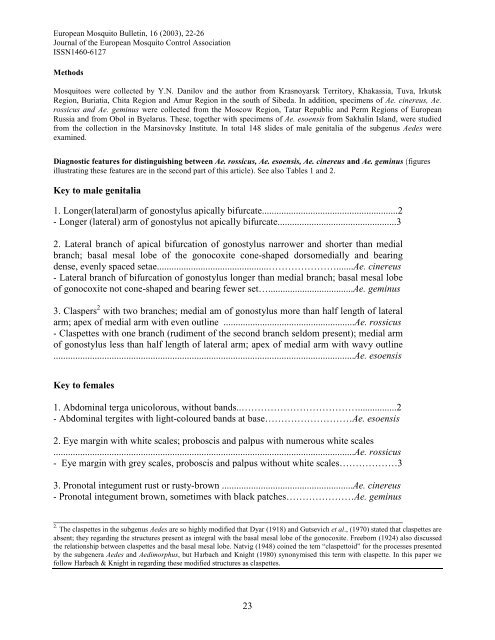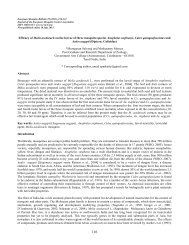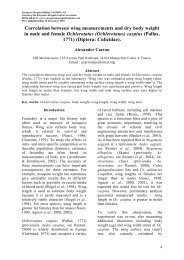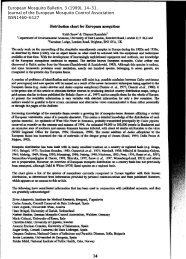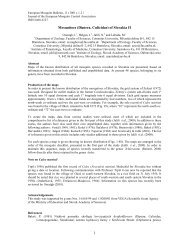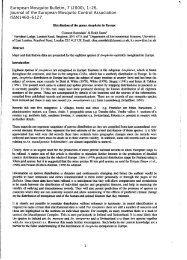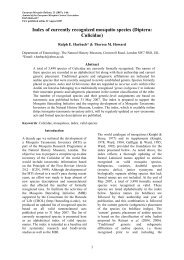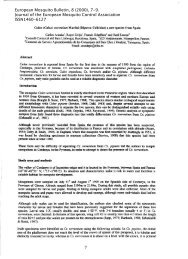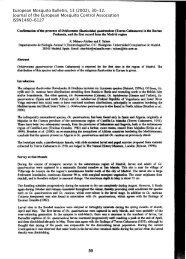Diptera, Culicidae, Aedes - European Mosquito Bulletin Journal of ...
Diptera, Culicidae, Aedes - European Mosquito Bulletin Journal of ...
Diptera, Culicidae, Aedes - European Mosquito Bulletin Journal of ...
You also want an ePaper? Increase the reach of your titles
YUMPU automatically turns print PDFs into web optimized ePapers that Google loves.
<strong>European</strong> <strong>Mosquito</strong> <strong>Bulletin</strong>, 16 (2003), 22-26<strong>Journal</strong> <strong>of</strong> the <strong>European</strong> <strong>Mosquito</strong> Control AssociationISSN1460-6127Methods<strong>Mosquito</strong>es were collected by Y.N. Danilov and the author from Krasnoyarsk Territory, Khakassia, Tuva, IrkutskRegion, Buriatia, Chita Region and Amur Region in the south <strong>of</strong> Sibeda. In addition, specimens <strong>of</strong> Ae. cinereus, Ae.rossicus and Ae. geminus were collected from the Moscow Region, Tatar Republic and Perm Regions <strong>of</strong> <strong>European</strong>Russia and from Obol in Byelarus. These, together with specimens <strong>of</strong> Ae. esoensis from Sakhalin Island, were studiedfrom the collection in the Marsinovsky Institute. In total 148 slides <strong>of</strong> male genitalia <strong>of</strong> the subgenus <strong>Aedes</strong> wereexamined.Diagnostic features for distinguishing between Ae. rossicus, Ae. esoensis, Ae. cinereus and Ae. geminus (figuresillustrating these features are in the second part <strong>of</strong> this article). See also Tables 1 and 2.Key to male genitalia1. Longer(lateral)arm <strong>of</strong> gonostylus apically bifurcate........................................................2- Longer (lateral) arm <strong>of</strong> gonostylus not apically bifurcate.................................................32. Lateral branch <strong>of</strong> apical bifurcation <strong>of</strong> gonostylus narrower and shorter than medialbranch; basal mesal lobe <strong>of</strong> the gonocoxite cone-shaped dorsomedially and bearingdense, evenly spaced setae..............................................………………….......Ae. cinereus- Lateral branch <strong>of</strong> bifurcation <strong>of</strong> gonostylus longer than medial branch; basal mesal lobe<strong>of</strong> gonocoxite not cone-shaped and bearing fewer set…...................................Ae. geminus3. Claspers 2 with two branches; medial am <strong>of</strong> gonostylus more than half length <strong>of</strong> lateralarm; apex <strong>of</strong> medial arm with even outline ......................................................Ae. rossicus- Claspettes with one branch (rudiment <strong>of</strong> the second branch seldom present); medial arm<strong>of</strong> gonostylus less than half length <strong>of</strong> lateral arm; apex <strong>of</strong> medial arm with wavy outline............................................................................................................................Ae. esoensisKey to females1. Abdominal terga unicolorous, without bands..………………………………................2- Abdominal tergites with light-coloured bands at base………………………Ae. esoensis2. Eye margin with white scales; proboscis and palpus with numerous white scales............................................................................................................................Ae. rossicus- Eye margin with grey scales, proboscis and palpus without white scales………………33. Pronotal integument rust or rusty-brown ......................................................Ae. cinereus- Pronotal integument brown, sometimes with black patches…………………Ae. geminus________________________________________________________________________2. The claspettes in the subgenus <strong>Aedes</strong> are so highly modified that Dyar (1918) and Gutsevich et al., (1970) stated that claspettes areabsent; they regarding the structures present as integral with the basal mesal lobe <strong>of</strong> the gonocoxite. Freeborn (1924) also discussedthe relationship between claspettes and the basal mesal lobe. Natvig (1948) coined the tem “claspettoid” for the processes presentedby the subgenera <strong>Aedes</strong> and Aedimorphus, but Harbach and Knight (1980) synonymised this term with claspette. In this paper wefollow Harbach & Knight in regarding these modified structures as claspettes.23


